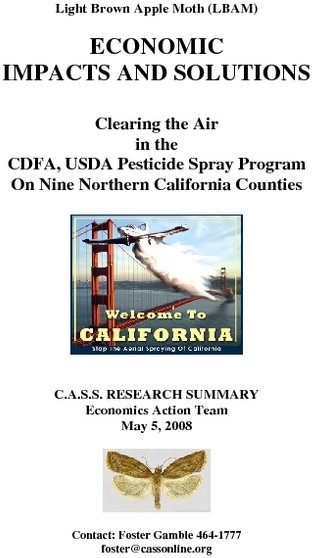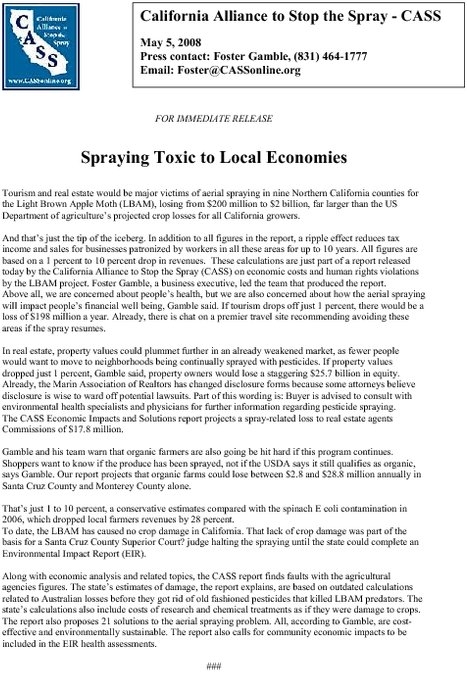From the Open-Publishing Calendar
From the Open-Publishing Newswire
Indybay Feature
California
Santa Cruz Indymedia
U.S.
Environment & Forest Defense
Government & Elections
Health, Housing & Public Services
Police State & Prisons
CASS releases economic impact report on LBAM pesticide spray program.
On May 5th, 2008, Foster Gamble and the Economic Action Team of the 'California Alliance to Stop the Spray' released a forty page report on the negative economic impact to the state of California if the CDFA wet dream to spray millions of California residents with a micronized chemical soup goes forward. Despite numerous press releases, the corporate media remains silent on the grave implications to the State’s economy and continues to parrot CDFA disinformation and propaganda.
The ‘California Alliance to Stop the Spray’ (C.A.S.S.) has released it's study of the economic impact to the state of California in response to the CDFA/USDA plan to spray multiple California counties with a micronized concoction of synthetic “pheromone” and chemicals to "eradicate" the Light Brown Apple Moth – a moth with zero history of causing crop damage anywhere in the world.
C.A.S.S. has uncovered several segments of the California economy that will sustain heavy negative impact if the spraying program goes forward. These include the areas of tourism, real estate and organic farming, among others. The report shows that the expected losses in these areas will dwarf the financial losses the CDFA claims big California agri-business will incur if the moth is not eradicated.
This very thorough report by Gamble and the C.A.S.S. Economic Team sheds light on the CDFA subterfuge currently in the works with federal backing by Bush administration agencies including the USDA and Homeland Security. In addition, the report provides an extensive summary of the history of federal government crimes of using United States citizens in chemical and drug experiments without our knowledge or consent.
The report can be found at:
http://cassonline.org/docs/CASS-EconReport.pdf
We must demand that the state of California and the federal government end it's criminal intent to spray us with poison without our consent. Please read this excellent report by C.A.S.S. and disseminate far and wide. Everyone in California needs to understand the risks to their economic well-being in addition to the many risks to their health.
And, if it comes to pass that we are not successful in mobilizing enough of our fellow California citizens to stand up for and demand our right not be used as human guinea pigs for the State, then it is incumbent upon all of us to communicate the inherent health risks of breathing California air with everyone we know who plans to visit the state for business or pleasure. We have to remember - if we don't stop this crime, citiizens and visitors alike will be subjected to breathing poison every day for at least nine months out of the year for up to ten years or as CDFA Secretary, A. G. Kawamura puts it "as long as it takes."
You can find the latest information on the LBAM spray issue at: http://cassonline.org/ and http://lbamspray.com
C.A.S.S. has uncovered several segments of the California economy that will sustain heavy negative impact if the spraying program goes forward. These include the areas of tourism, real estate and organic farming, among others. The report shows that the expected losses in these areas will dwarf the financial losses the CDFA claims big California agri-business will incur if the moth is not eradicated.
This very thorough report by Gamble and the C.A.S.S. Economic Team sheds light on the CDFA subterfuge currently in the works with federal backing by Bush administration agencies including the USDA and Homeland Security. In addition, the report provides an extensive summary of the history of federal government crimes of using United States citizens in chemical and drug experiments without our knowledge or consent.
The report can be found at:
http://cassonline.org/docs/CASS-EconReport.pdf
We must demand that the state of California and the federal government end it's criminal intent to spray us with poison without our consent. Please read this excellent report by C.A.S.S. and disseminate far and wide. Everyone in California needs to understand the risks to their economic well-being in addition to the many risks to their health.
And, if it comes to pass that we are not successful in mobilizing enough of our fellow California citizens to stand up for and demand our right not be used as human guinea pigs for the State, then it is incumbent upon all of us to communicate the inherent health risks of breathing California air with everyone we know who plans to visit the state for business or pleasure. We have to remember - if we don't stop this crime, citiizens and visitors alike will be subjected to breathing poison every day for at least nine months out of the year for up to ten years or as CDFA Secretary, A. G. Kawamura puts it "as long as it takes."
You can find the latest information on the LBAM spray issue at: http://cassonline.org/ and http://lbamspray.com
For more information:
http://cassonline.org/docs/CASS-EconReport...
Add Your Comments
Comments
(Hide Comments)
Tourism and real estate would be major victims of aerial spraying in nine Northern California counties for
the Light Brown Apple Moth (LBAM), losing from $200 million to $2 billion, far larger than the US
Department of agriculture’s projected crop losses for all California growers.
And that’s just the tip of the iceberg. In addition to all figures in the report, a ripple effect reduces tax
income and sales for businesses patronized by workers in all these areas for up to 10 years. All figures are
based on a 1 percent to 10 percent drop in revenues. These calculations are just part of a report released
today by the California Alliance to Stop the Spray (CASS) on economic costs and human rights violations
by the LBAM project. Foster Gamble, a business executive, led the team that produced the report.
Above all, we are concerned about people’s health, but we are also concerned about how the aerial spraying
will impact people’s financial well being, Gamble said. If tourism drops off just 1 percent, there would be a
loss of $198 million a year. Already, there is chat on a premier travel site recommending avoiding these
areas if the spray resumes.
In real estate, property values could plummet further in an already weakened market, as fewer people
would want to move to neighborhoods being continually sprayed with pesticides. If property values
dropped just 1 percent, Gamble said, property owners would lose a staggering $25.7 billion in equity.
Already, the Marin Association of Realtors has changed disclosure forms because some attorneys believe
disclosure is wise to ward off potential lawsuits. Part of this wording is: Buyer is advised to consult with
environmental health specialists and physicians for further information regarding pesticide spraying.
The CASS Economic Impacts and Solutions report projects a spray-related loss to real estate agents
Commissions of $17.8 million.
Gamble and his team warn that organic farmers are also going be hit hard if this program continues.
Shoppers want to know if the produce has been sprayed, not if the USDA says it still qualifies as organic,
says Gamble. Our report projects that organic farms could lose between $2.8 and $28.8 million annually in
Santa Cruz County and Monterey County alone.
That’s just 1 to 10 percent, a conservative estimates compared with the spinach E coli contamination in
2006, which dropped local farmers revenues by 28 percent.
To date, the LBAM has caused no crop damage in California. That lack of crop damage was part of the
basis for a Santa Cruz County Superior Court judge halting the spraying until the state could complete an
Environmental Impact Report (EIR).
Along with economic analysis and related topics, the CASS report finds faults with the agricultural
agencies figures. The state’s estimates of damage, the report explains, are based on outdated calculations
related to Australian losses before they got rid of old fashioned pesticides that killed LBAM predators. The
state’s calculations also include costs of research and chemical treatments as if they were damage to crops.
The report also proposes 21 solutions to the aerial spraying problem. All, according to Gamble, are cost-
effective and environmentally sustainable. The report also calls for community economic impacts to be
included in the EIR health assessments.
the Light Brown Apple Moth (LBAM), losing from $200 million to $2 billion, far larger than the US
Department of agriculture’s projected crop losses for all California growers.
And that’s just the tip of the iceberg. In addition to all figures in the report, a ripple effect reduces tax
income and sales for businesses patronized by workers in all these areas for up to 10 years. All figures are
based on a 1 percent to 10 percent drop in revenues. These calculations are just part of a report released
today by the California Alliance to Stop the Spray (CASS) on economic costs and human rights violations
by the LBAM project. Foster Gamble, a business executive, led the team that produced the report.
Above all, we are concerned about people’s health, but we are also concerned about how the aerial spraying
will impact people’s financial well being, Gamble said. If tourism drops off just 1 percent, there would be a
loss of $198 million a year. Already, there is chat on a premier travel site recommending avoiding these
areas if the spray resumes.
In real estate, property values could plummet further in an already weakened market, as fewer people
would want to move to neighborhoods being continually sprayed with pesticides. If property values
dropped just 1 percent, Gamble said, property owners would lose a staggering $25.7 billion in equity.
Already, the Marin Association of Realtors has changed disclosure forms because some attorneys believe
disclosure is wise to ward off potential lawsuits. Part of this wording is: Buyer is advised to consult with
environmental health specialists and physicians for further information regarding pesticide spraying.
The CASS Economic Impacts and Solutions report projects a spray-related loss to real estate agents
Commissions of $17.8 million.
Gamble and his team warn that organic farmers are also going be hit hard if this program continues.
Shoppers want to know if the produce has been sprayed, not if the USDA says it still qualifies as organic,
says Gamble. Our report projects that organic farms could lose between $2.8 and $28.8 million annually in
Santa Cruz County and Monterey County alone.
That’s just 1 to 10 percent, a conservative estimates compared with the spinach E coli contamination in
2006, which dropped local farmers revenues by 28 percent.
To date, the LBAM has caused no crop damage in California. That lack of crop damage was part of the
basis for a Santa Cruz County Superior Court judge halting the spraying until the state could complete an
Environmental Impact Report (EIR).
Along with economic analysis and related topics, the CASS report finds faults with the agricultural
agencies figures. The state’s estimates of damage, the report explains, are based on outdated calculations
related to Australian losses before they got rid of old fashioned pesticides that killed LBAM predators. The
state’s calculations also include costs of research and chemical treatments as if they were damage to crops.
The report also proposes 21 solutions to the aerial spraying problem. All, according to Gamble, are cost-
effective and environmentally sustainable. The report also calls for community economic impacts to be
included in the EIR health assessments.
For more information:
http://lbamspray.com/
We are 100% volunteer and depend on your participation to sustain our efforts!
Get Involved
If you'd like to help with maintaining or developing the website, contact us.
Publish
Publish your stories and upcoming events on Indybay.
Topics
More
Search Indybay's Archives
Advanced Search
►
▼
IMC Network




